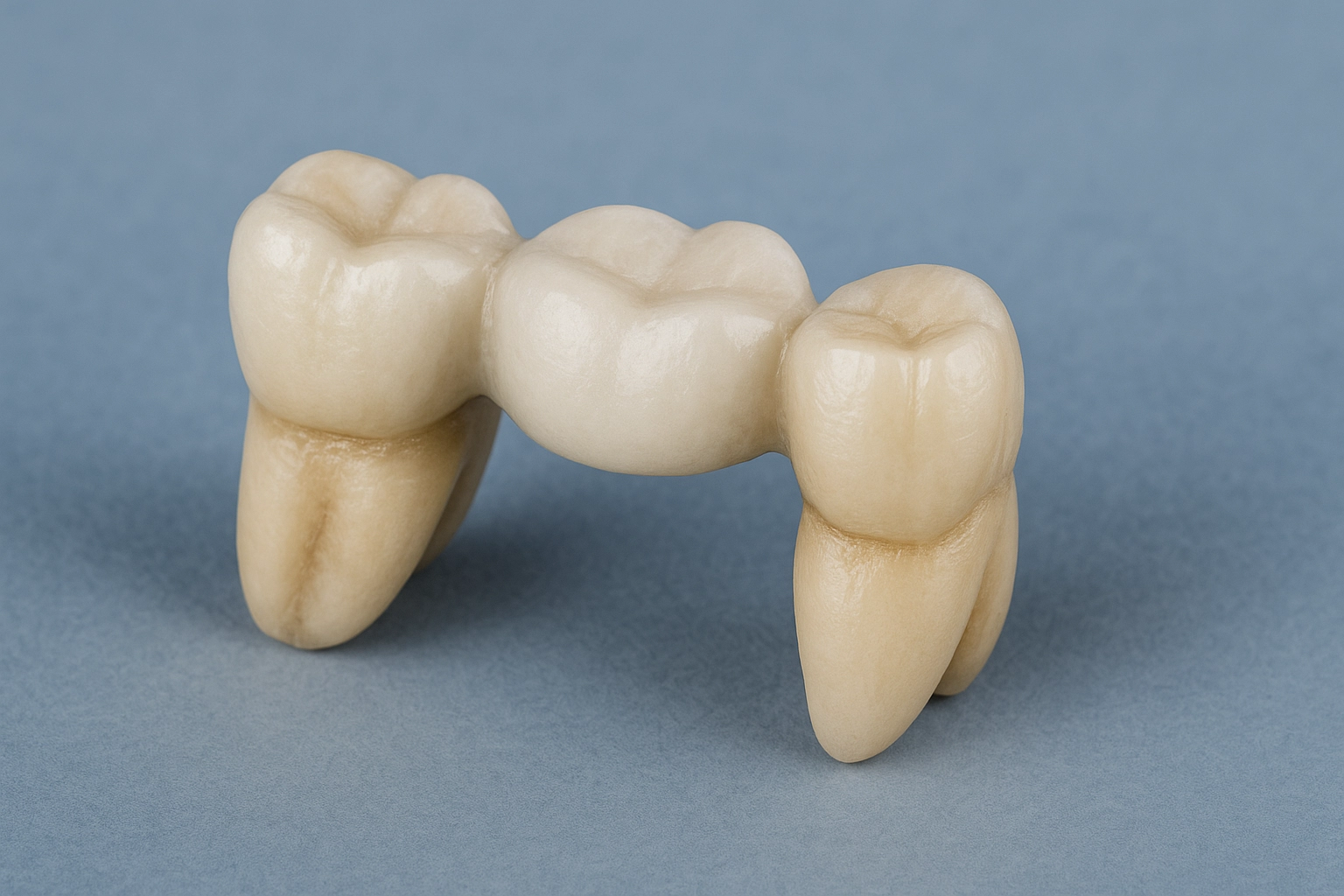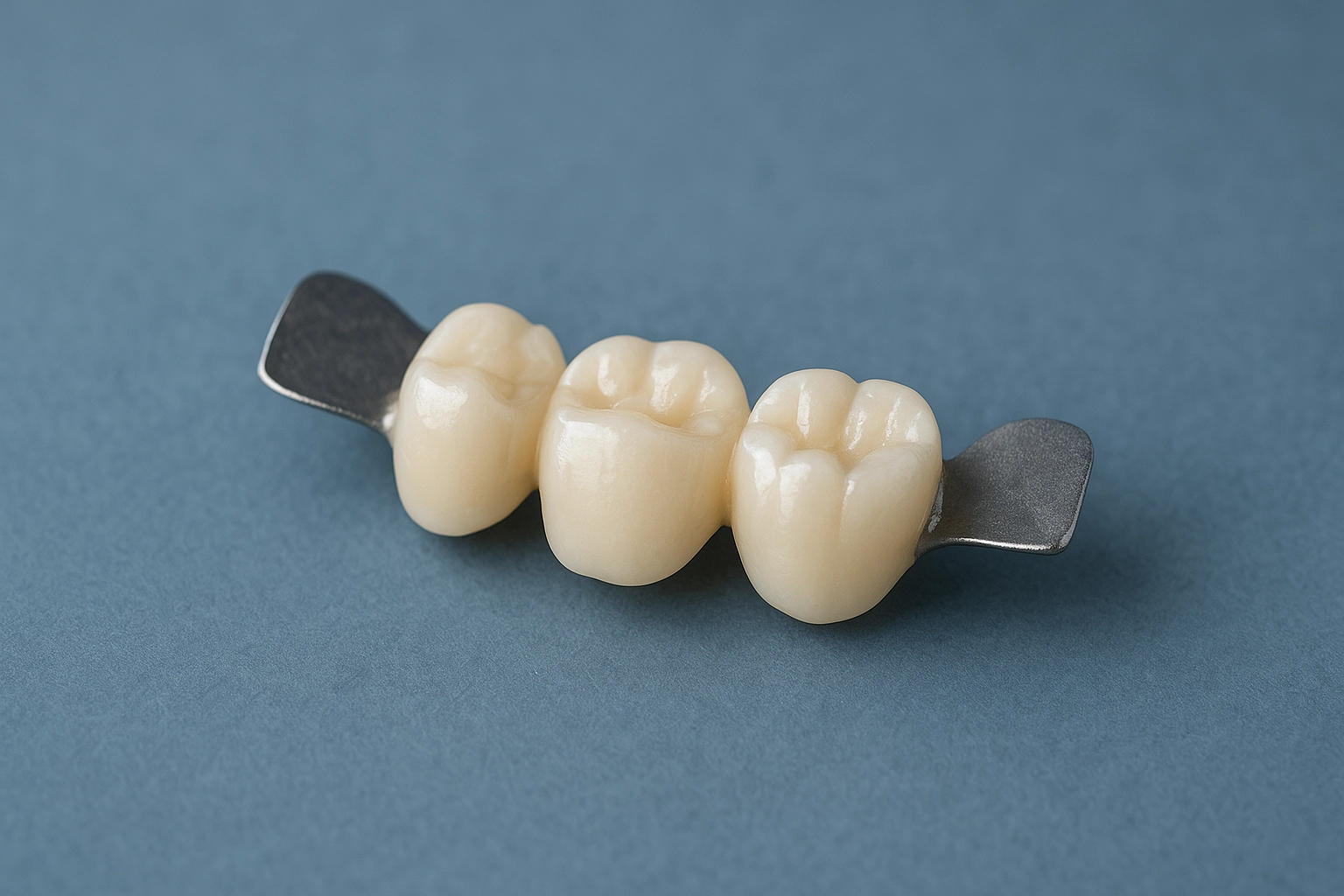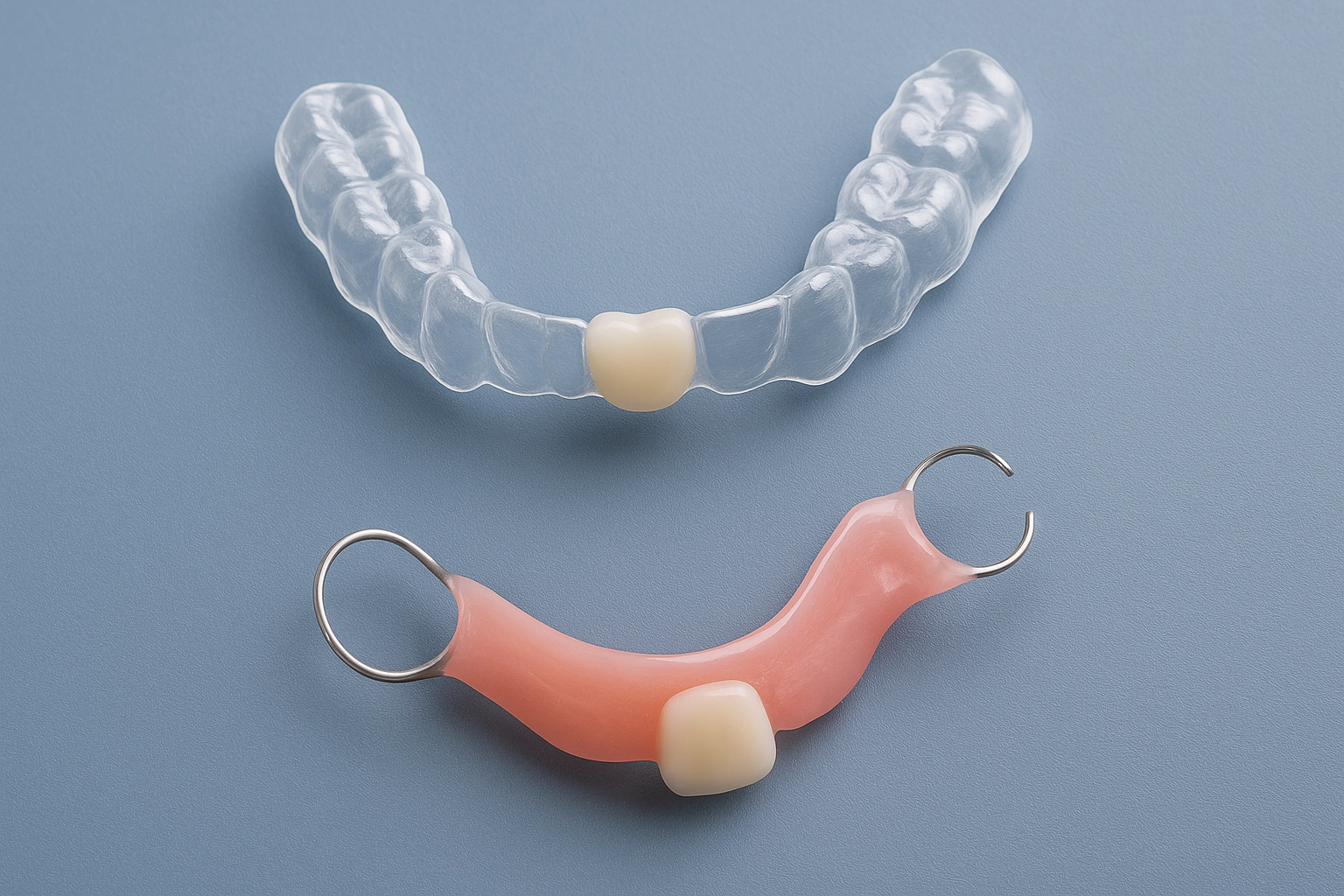
Pontic Solutions - How to Replace Missing Teeth
Tooth loss can impact not only your smile but also your oral health and overall well-being. Whether due to decay, injury, or periodontal disease, replacing missing teeth is crucial to prevent further complications.
One effective solution in restorative dentistry is the use of pontics - artificial teeth that fill the gaps left by missing natural teeth.
Pontics are integral components of dental bridges, designed to restore function and aesthetics. At Brighton Implant Clinic, we specialize in advanced restorative and implant dentistry, offering tailored solutions to meet each patient's unique needs.
What Is a Pontic? A Foundational Overview
A pontic is an artificial tooth used in a dental bridge to replace a missing tooth. It is anchored to adjacent teeth or dental implants, effectively "bridging" the gap. Pontics restore the appearance and function of natural teeth, allowing for normal chewing and speaking.
The design and material of a pontic are carefully selected based on the location of the missing tooth, the health of adjacent teeth, and aesthetic considerations. Common materials include porcelain, zirconia, and metal alloys, each offering specific benefits in terms of durability and appearance.
Why Replace Missing Teeth? Health, Function, and Confidence

Leaving a gap from a missing tooth can lead to several issues:
- Bone Loss: The jawbone requires stimulation from tooth roots to maintain its density. Missing teeth can lead to bone resorption over time.
- Shifting Teeth: Adjacent teeth may drift into the empty space, causing misalignment and bite problems.
- Gum Disease and Decay: Gaps can become traps for food particles and bacteria, increasing the risk of periodontal disease and tooth decay.
- Aesthetic Concerns: Missing teeth can affect your smile and facial structure, impacting self-esteem and confidence.
Replacing missing teeth with pontics helps maintain oral health, restore function, and enhance appearance.
Types of Pontic Designs: Choosing the Right Shape
Pontic design is crucial for comfort, hygiene, and aesthetics. Common designs include:
- Hygienic (Sanitary) Pontic: Designed for easy cleaning, it doesn't contact the gum tissue, making it suitable for posterior teeth where aesthetics are less critical.
- Ridge Lap Pontic: Overlaps the ridge on the facial side, providing a natural appearance but can be challenging to clean.
- Modified Ridge Lap Pontic: Combines aesthetics with better hygiene by contacting the ridge only on the facial side.
- Ovate Pontic: Sits in a depression in the gum tissue, offering superior aesthetics, especially for front teeth.
- Conical Pontic: Shaped like a cone, it's easy to clean and suitable for thin ridges.
The choice depends on the location of the missing tooth, aesthetic requirements, and hygiene considerations.
Fixed Pontic Solutions: Dental Bridges Explained

Fixed dental bridges are non-removable prosthetics that replace one or more missing teeth. Types include:
- Traditional Bridges: Involve crowns on adjacent teeth with a pontic in between. Suitable when healthy teeth are present on both sides of the gap.
- Cantilever Bridges: Used when only one adjacent tooth is available. Less common due to potential stress on the supporting tooth.
- Maryland (Resin-Bonded) Bridges: Feature a pontic held in place by metal or porcelain wings bonded to adjacent teeth. Minimal alteration to existing teeth is required.
- Implant-Supported Bridges: Anchored by dental implants, providing a stable and durable solution without affecting adjacent teeth.
Each type has specific indications based on the patient's oral condition and preferences.
Removable Pontic Solutions: Dentures and Partials
Removable prosthetic options offer patients flexibility and affordability when addressing tooth loss. These solutions are particularly beneficial for individuals seeking non-invasive treatments or those with budgetary constraints.
Complete dentures are designed to replace all teeth in either the upper or lower arch. They rest directly on the gums and are custom-made to fit the patient's mouth, restoring both function and aesthetics. Complete dentures are typically recommended for patients who have lost all their teeth in a particular arch due to decay, gum disease, or trauma.
Partial dentures, on the other hand, are suitable for patients missing several teeth but still retaining some natural teeth. These dentures consist of replacement teeth attached to a gum-colored acrylic base, often reinforced with a metal framework. They are designed to fit snugly around the remaining natural teeth, filling in the gaps and preventing the shifting of adjacent teeth.
While removable dentures are less invasive and more cost-effective compared to fixed solutions, they may offer less stability and comfort. Patients might experience movement of the dentures during speaking or eating, and some may find them bulkier than fixed alternatives. Regular maintenance and adjustments are essential to ensure optimal fit and function over time.
Temporary Pontic Options: Bridging the Gap During Treatment

Temporary pontic solutions play a crucial role in maintaining aesthetics and function during the interim period of dental treatments, such as while awaiting the placement of a permanent bridge or dental implant. These solutions help preserve the patient's appearance and prevent adjacent teeth from shifting into the gap left by a missing tooth.
One common temporary option is the Essix retainer with a pontic. This clear, removable appliance is custom-made to fit over the patient's existing teeth, with an artificial tooth embedded to fill the gap. Essix retainers are non-invasive, aesthetically pleasing, and can be fabricated quickly, often within a day. However, they are not designed for eating and should be removed during meals to prevent damage.
Another temporary solution is the flipper, an acrylic removable partial denture that replaces one or more missing teeth. Flippers are lightweight, cost-effective, and can be worn while eating, although patients are advised to avoid chewing directly on the flipper's artificial tooth. They are typically used as a short-term solution during the healing period following tooth extraction or implant placement.
While both Essix retainers and flippers serve as effective temporary measures, they are not intended for long-term use. Patients should consult with their dental professional to determine the most appropriate permanent solution for replacing missing teeth.
Materials Used in Pontic Fabrication: Durability Meets Aesthetics
Selecting the appropriate material for pontic fabrication is crucial to ensure the longevity, functionality, and aesthetic appeal of dental restorations. The choice depends on various factors, including the location of the missing tooth, patient preferences, and budget considerations.
Porcelain-Fused-to-Metal (PFM) Bridges
PFM bridges combine the strength of a metal substructure with the natural appearance of porcelain. This combination offers durability and aesthetics, making it suitable for both anterior and posterior restorations. However, over time, the metal may become visible at the gum line, and there's a risk of porcelain chipping.
All-Ceramic Bridges
All-ceramic bridges, made entirely of ceramic materials like lithium disilicate, provide excellent aesthetics due to their translucency, closely mimicking natural teeth. They are biocompatible and free from metal, reducing the risk of allergic reactions. However, they may not be as strong as metal-based options, making them more suitable for front teeth replacements.
Zirconia Bridges
Zirconia is a type of ceramic known for its exceptional strength and durability. Zirconia bridges are highly resistant to fracture and wear, making them ideal for replacing molars and other posterior teeth. They also offer good aesthetics, although they may be less translucent than other ceramics.
Metal Bridges
Metal bridges, typically made from gold or base metal alloys, are known for their strength and longevity. They are less likely to fracture and are highly resistant to wear. However, their metallic color makes them less suitable for visible areas, and they may not be the first choice for patients prioritizing aesthetics.
Composite Resin Bridges
Composite resin bridges are often used as temporary solutions. They are cost-effective and can be fabricated quickly. However, they are less durable than other materials and may discolor over time, making them less suitable for long-term use.
Each material has its advantages and limitations. The choice should be made in consultation with a dental professional, considering the specific needs and circumstances of the patient.
Factors Influencing Pontic Selection: Personalized Dental Care

Selecting the appropriate pontic design and material is a nuanced process that considers multiple factors to ensure optimal function, aesthetics, and oral health.
- Location of the Missing Tooth: Anterior teeth, visible when smiling or speaking, often necessitate pontics with superior aesthetics, such as ovate or modified ridge lap designs. Posterior teeth, subjected to higher masticatory forces, may benefit from hygienic or conical pontics that prioritize durability and ease of cleaning.
- Condition of Adjacent Teeth and Oral Structures: The health and alignment of neighboring teeth influence the choice of pontic. For instance, if adjacent teeth are strong and healthy, a traditional bridge may be suitable. Conversely, if adjacent teeth are compromised, implant-supported pontics might be a better option to avoid placing additional stress on them.
- Patient's Oral Hygiene Practices and Commitment: Some pontic designs require meticulous cleaning to prevent plaque accumulation and gum disease. Patients must be committed to maintaining excellent oral hygiene to ensure the longevity of the restoration.
- Budget Considerations and Insurance Coverage: Financial factors can influence the selection of pontic materials and designs. While some options may have higher upfront costs, they might offer better durability and aesthetics, potentially reducing long-term expenses.
Maintenance and Care for Pontic Restorations
Proper maintenance of pontic restorations is crucial to ensure their longevity and the health of surrounding oral tissues.
- Daily Cleaning Routines: Regular brushing with a soft-bristled toothbrush and fluoride toothpaste is essential. Flossing around the pontic area using floss threaders or interdental brushes helps remove plaque and food particles. Water flossers can also be beneficial in maintaining cleanliness beneath the pontic.
- Regular Dental Check-Ups and Professional Cleanings: Routine visits to the dentist allow for professional cleaning and early detection of potential issues. Professional cleanings help remove tartar buildup that cannot be eliminated by regular brushing and flossing.
- Recognizing Signs of Wear or Complications: Patients should be vigilant for signs such as discomfort, mobility of the pontic, or changes in bite. Any of these symptoms warrant prompt dental evaluation to address potential problems.
- Dietary Considerations to Prolong the Life of the Restoration: Avoiding hard or sticky foods can prevent damage to the pontic. A balanced diet rich in vitamins and minerals supports overall oral health, contributing to the longevity of dental restorations.
Frequently Asked Questions (FAQs)
What is the difference between a pontic and a dental implant?
A pontic is an artificial tooth used in a dental bridge to replace a missing tooth, typically anchored to adjacent natural teeth. In contrast, a dental implant is a titanium post surgically placed into the jawbone, serving as a root for a replacement tooth. Implants are independent restorations that do not rely on neighboring teeth for support.
How long do dental bridges with pontics last?
With proper care and maintenance, dental bridges can last between 5 to 15 years. Factors influencing their longevity include oral hygiene practices, the materials used, and regular dental check-ups.
Are pontic restorations covered by dental insurance?
Coverage for pontic restorations varies depending on the insurance plan. It's advisable to consult with your insurance provider and dental clinic's billing department to understand the specifics of your coverage.
Can I eat normally with a pontic restoration?
Yes, after an initial adjustment period, most patients can resume normal eating habits. However, it's recommended to avoid excessively hard or sticky foods that could damage the restoration.
Is the procedure for getting a pontic painful?
The procedure is typically performed under local anesthesia, minimizing discomfort. Post-procedure soreness is usually mild and temporary, manageable with over-the-counter pain relievers.
Conclusion
Replacing missing teeth is vital for maintaining oral health, functionality, and aesthetics. Pontic solutions, whether part of a bridge or supported by implants, offer effective means to restore your smile. At Brighton Implant Clinic, our dedicated team is committed to providing personalized, high-quality dental care to help you achieve optimal oral health.
If you're considering tooth replacement options, we invite you to schedule a consultation to explore the best solutions tailored to your needs.










